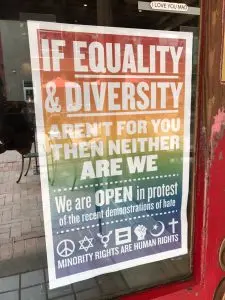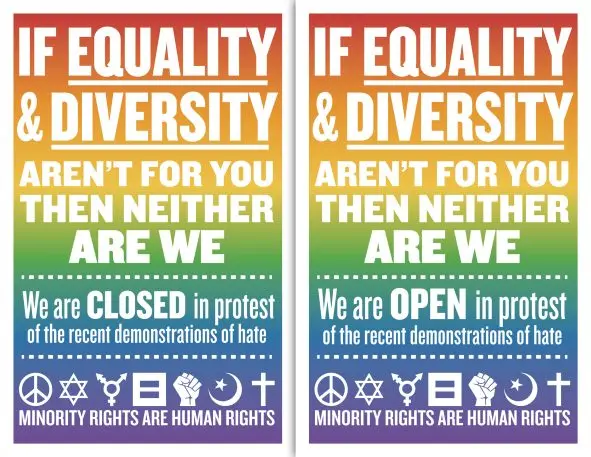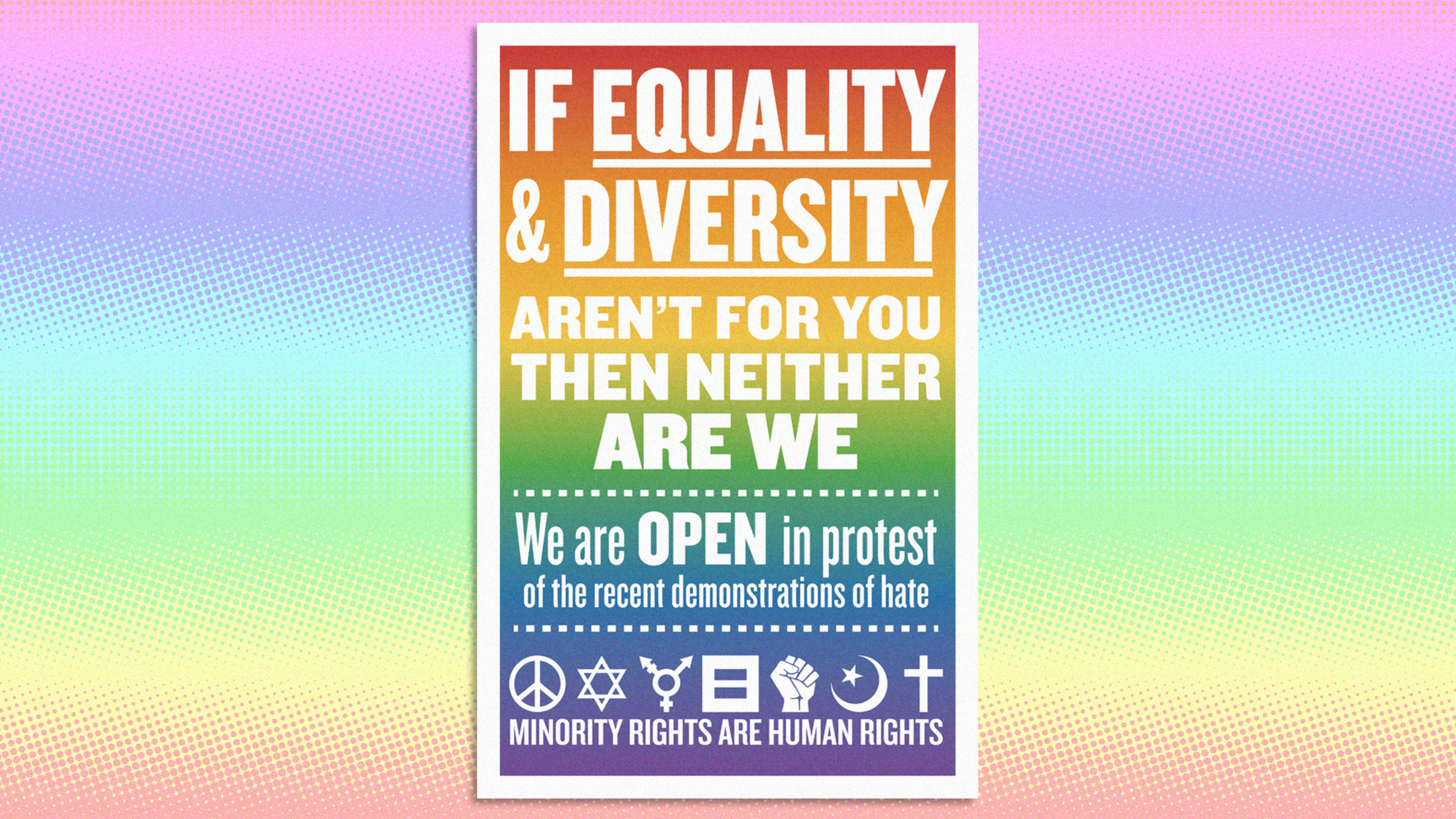Store owners in downtown Charlottesville, Virginia, faced a couple of tough questions in the days leading up the last weekend’s “Unite the Right” rally of white nationalist hate groups, which ultimately turned violent and fatal, leaving one counter-protester murdered, several more in critical condition, and dozens wounded.
Should they close or stay open? And what message would their decision send to their community?

Many downtown businesses had petitioned the city to move the event to a larger park farther away from downtown, fearing that the turnout would overrun the small city, and that armed white nationalists might pose a danger.
Whether or not those stores stayed open or closed, though, many did ultimately make a unity statement: It’s told through four variations of an 11-by-17 poster that went up in many store windows prior to the rally. The message has been eye-catching enough to be seen in the background of news reports and photos, and powerful enough to have been shared over Twitter by everyone from Charlottesville Mayor Mike Signor (who was supportive) and white nationalist instigator Richard Spencer, who was indignant.

Each was made available in one of two color styles–black and white or rainbow. [Image: courtesy Joe Seddon]The sign’s creator (who is uncredited on the work) is Joe Seddon, a 27-year-old local graphic designer, who also works for a custom T-shirt company. In Seddon’s mind, shopkeepers were in a tricky situation because closing might look like they were avoiding the issue, rather than being open with a more aggressive statement about who they would serve. Staying open, meanwhile, could look like they were happy to earn money from the event, whereas owners more likely wanted to provide support and refuge to the community. “I just wanted to give people an opportunity to have a voice they might otherwise not have had,” he says.
Seddon made the first sign–the rainbow and staying open theme–originally just for Escafe, a restaurant and bar owned by his boyfriend, Todd Hamilton, who, he says, wanted to assure people they would have a safe place to go during the fracas. The shop posted an armed guard out front to make that point on Saturday.
Hamilton eventually shared that design and the other options in a printable format on an email thread that included dozens of downtown owners. Upon request, Seddon printed poster-size versions and gave out 90.
“They were absolutely free,” he adds. “I didn’t attribute myself on them. I just made them for the community and wanted them to be available so that people could make whatever statement they were interested in making.”
“The people that were coming in were interlopers. They don’t live here and we just weren’t going to tolerate it.” [Photo: courtesy John Lawrence]Hanging posters in support of equality isn’t a new thing. Before a Ku Klux Klan rally there in July, many Charlottesville owners placed placards that read “Unity C’Ville,” referencing a same-named coalition of nonprofits and local businesses organized to create events and spaces that honor diversity and cultural understanding.
Those announcements, though, do appear a bit understated considering the white nationalists has graduated to tactics that include marchers waving torches and flags with swastikas. This time, Seddon says most owners gravitated toward the rainbow-colored version. “I think a lot of people here in Charlottesville were really outraged by what was going to happen and were prepared to make a bold statement, so they went the bolder route, which I really appreciate.”
Some store owners expecting to be open changed their mind on Saturday, after an unruly torch-bearing mob descended on the University of Virginia campus the night before and physically assaulted a group of counter demonstrators. There’s no firm count, but about 60 of the 80 stores associated with the Downtown Business Association of Charlottesville chose to stay open on Saturday, says Joan Fenton, the chair of the DBAC, who owns a quilts and artisanal goods store and women’s clothing shop in the area.
At first, businesses coordinated those intentions online through email chains, but eventually moved to Slack to make sure that there were at least several places per block for residents to find water or take shelter.
John Lawrence, the owner of Mudhouse Coffee Roasters, a store located a block and a half from Emancipation Park says Seddon’s signs helped signal where refuge was available. “We wanted to put those up so that people knew that there was solidarity,” he says. “The people that were coming in were interlopers. They don’t live here and we just weren’t going to tolerate it.”
Lawrence, who ended up closing on Saturday to protect his employees, was part of a group that stayed in the store during the protests to unlock doors for anyone “being chased . . . by nazis.”
When reached by phone on Monday, Joan Fenton confessed that she’d been too busy to actually hang up Seddon’s sign because the effort of coordinating information between shop owners, city hall, and the police had taken precedence. But for some reason the opportunity didn’t feel like it had passed. “I’m looking at one across the street from me and thinking I can still put mine up.”
In fact, Lawrence, the coffee shop owner, says he plans to leave his hanging for a bit, even though it’s technically outdated, as a symbol of unity. “I’m sure there will be new signs [made], but somebody was murdered by terrorists just down the block,” he says, noting the death of Heather Heyer, a 32-year-old counter-protester, who was struck in a car attack by an avowed white nationalist who has since been arrested. “It’s fresh, it’s intense, and everybody’s feeling it.”
Recognize your brand’s excellence by applying to this year’s Brands That Matter Awards before the final deadline, June 7.
Sign up for Brands That Matter notifications here.
